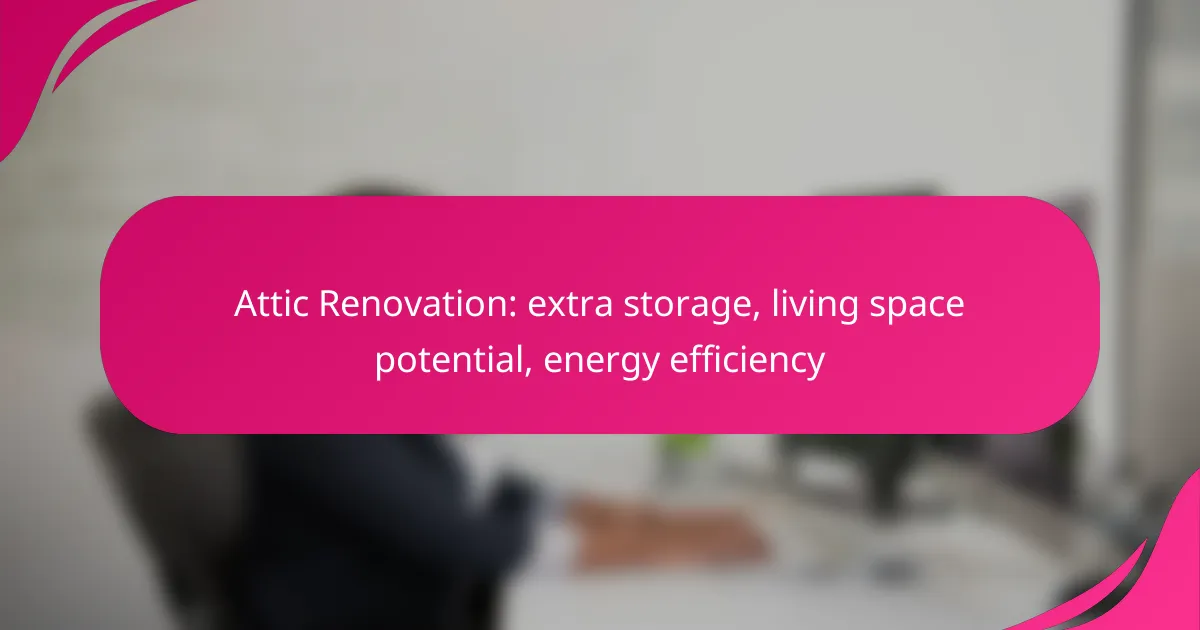Renovating your attic can unlock a wealth of potential, providing extra storage solutions and transforming the space into functional living areas. This upgrade not only increases your home’s value but also enhances energy efficiency through improved insulation and ventilation, ultimately leading to lower utility costs. Embrace the opportunity to maximize your home’s utility and appeal with a thoughtful attic renovation.

How can attic renovation provide extra storage in urban homes?
Renovating an attic can significantly enhance storage options in urban homes, where space is often limited. By transforming this underutilized area, homeowners can create organized storage solutions that maximize available space while keeping the living areas clutter-free.
Built-in shelving solutions
Built-in shelving is an effective way to utilize the unique angles and dimensions of an attic. These shelves can be custom-fitted to the walls, providing ample space for books, decorative items, or storage bins. Consider using materials that match the existing decor to create a seamless look.
When planning built-in shelving, ensure that the shelves are sturdy enough to hold heavier items. A depth of 12 to 16 inches is generally sufficient for most storage needs, while adjustable shelves can offer flexibility for varying item sizes.
Custom storage units
Custom storage units can be designed to fit specific needs and dimensions of the attic. These units can include drawers, cabinets, or open shelving, tailored to store seasonal items, clothing, or even hobby supplies. Investing in quality materials will ensure durability and longevity.
When designing custom storage, consider incorporating features like sliding doors or fold-down tables to maximize functionality without sacrificing space. It’s often beneficial to consult with a designer to optimize layout and aesthetics.
Utilizing vertical space
Maximizing vertical space is crucial in an attic renovation, as it allows for more storage without taking up floor area. Tall shelving units or hanging storage solutions can effectively use the height of the attic, making items more accessible while keeping the floor clear.
Incorporating hooks or pegboards on walls can also provide additional storage for tools or equipment. Aim to keep frequently used items within easy reach, while less-used items can be stored higher up, ensuring a practical and organized space.

What are the benefits of converting an attic into living space?
Converting an attic into living space offers numerous advantages, including increased property value, additional functional rooms, and enhanced living areas. This transformation can significantly improve your home’s utility and appeal, making it a worthwhile investment.
Increased home value
One of the primary benefits of converting an attic is the potential increase in your home’s market value. Real estate experts often suggest that adding usable square footage can raise property values by a significant percentage, particularly in urban areas where space is at a premium.
Before starting your project, consider consulting with a local real estate agent to understand how much value an attic conversion could add in your specific market. This insight can help you prioritize design elements that appeal to potential buyers.
Additional bedrooms or offices
Converting an attic can provide much-needed additional bedrooms or home offices, which are increasingly valuable in today’s remote work environment. A well-designed attic space can easily accommodate a cozy bedroom or a functional workspace, catering to your family’s needs.
When planning your conversion, ensure that the space meets local building codes, especially regarding ceiling height and egress requirements for bedrooms. This will not only enhance safety but also ensure the space is legally usable.
Enhanced family living area
An attic conversion can create a versatile family living area, perfect for relaxation, entertainment, or play. This additional space can serve as a game room, a media room, or a quiet reading nook, enhancing your family’s quality of life.
To maximize the comfort and functionality of your new living area, consider incorporating natural light through skylights or dormer windows. This can make the space feel larger and more inviting, while also improving energy efficiency.

How does attic renovation improve energy efficiency?
Attic renovation can significantly enhance energy efficiency by addressing insulation, windows, and ventilation. These improvements help maintain a stable indoor temperature, reducing heating and cooling costs over time.
Insulation upgrades
Upgrading insulation in the attic is crucial for energy efficiency. Proper insulation minimizes heat loss in winter and keeps the space cooler in summer, which can lower energy bills by a noticeable percentage.
Consider using materials like fiberglass, foam board, or spray foam, which offer varying R-values. The recommended R-value for attics in temperate climates typically ranges from R-30 to R-60, depending on local conditions.
Energy-efficient windows
Installing energy-efficient windows in the attic can further enhance energy savings. These windows are designed to reduce heat transfer, keeping your home comfortable year-round.
Look for windows with a low U-factor and high Solar Heat Gain Coefficient (SHGC). Double or triple glazing is common, and Energy Star-rated windows can provide significant long-term savings on energy costs.
Ventilation improvements
Improving ventilation in the attic is essential for maintaining air quality and temperature control. Proper airflow prevents moisture buildup, which can lead to mold and structural damage.
Consider installing ridge vents, soffit vents, or gable vents to promote effective air circulation. A balanced ventilation system can help reduce energy consumption by ensuring that your heating and cooling systems operate more efficiently.

What are the costs associated with attic renovation in major cities?
Attic renovation costs can vary significantly based on location, scope of work, and design choices. In major cities, homeowners can expect to spend anywhere from several thousand to tens of thousands of dollars depending on the complexity of the project.
Average renovation costs
The average cost for attic renovations in major cities typically ranges from $20,000 to $50,000. This price often includes insulation, flooring, and basic electrical work. More extensive renovations, such as adding a bathroom or dormer windows, can push costs higher.
For example, in cities like New York or San Francisco, costs may trend towards the higher end of this range due to increased demand and higher living expenses. In contrast, cities with lower living costs may offer more budget-friendly options.
Cost breakdown by materials
Material costs can significantly impact the overall budget for an attic renovation. Common materials include insulation, drywall, flooring, and windows, with insulation typically costing between $1 and $3 per square foot. High-quality flooring options, such as hardwood, can range from $5 to $15 per square foot.
When selecting materials, consider both upfront costs and long-term energy efficiency. Investing in better insulation may have a higher initial cost but can lead to savings on heating and cooling bills over time.
Labor costs in metropolitan areas
Labor costs for attic renovations in metropolitan areas can vary widely, often ranging from $50 to $150 per hour. Skilled tradespeople, such as electricians and carpenters, may command higher rates due to their expertise. It’s essential to obtain multiple quotes to ensure competitive pricing.
Additionally, consider the potential for increased costs due to local regulations or permits required for structural changes. Always check with local authorities to understand any necessary approvals before starting your renovation project.

What permits are required for attic renovations?
Attic renovations typically require several permits to ensure compliance with local building codes and regulations. These permits help guarantee that the renovation is safe, legal, and up to standard.
Building permits
Building permits are essential for any structural changes made during an attic renovation. This includes adding walls, windows, or altering the roof structure. Homeowners should check with their local building department to understand the specific requirements and application process.
Generally, the cost of building permits can vary significantly based on the project size and location, often ranging from a few hundred to several thousand dollars. It’s advisable to apply for permits early in the planning stage to avoid delays.
Electrical and plumbing permits
If your attic renovation includes electrical work or plumbing installations, you will need to secure additional permits for these systems. Electrical permits ensure that wiring meets safety standards, while plumbing permits cover any new fixtures or drainage systems.
These permits often require inspections by local authorities to verify compliance. Homeowners should consult licensed electricians and plumbers to ensure that all work is performed according to code, which can help streamline the permitting process.
Local zoning regulations
Local zoning regulations dictate how properties can be used and what modifications are permissible. Before starting an attic renovation, it’s crucial to check zoning laws to confirm that the planned changes comply with local land use policies.
Some areas may have restrictions on the height of buildings or the types of activities allowed in residential zones. Engaging with local zoning boards or planning departments can provide clarity on any limitations or requirements that may affect your renovation project.

How to choose the right contractor for attic renovation?
Selecting the right contractor for your attic renovation is crucial for ensuring quality work and a successful project. Focus on their experience, reputation, and ability to meet your specific needs.
Evaluating contractor experience
When evaluating a contractor’s experience, consider their years in the business and the number of attic renovations they have completed. Look for contractors who specialize in attic projects, as they will be more familiar with the unique challenges and requirements.
Request a portfolio of their previous work to assess the quality and style of their renovations. Additionally, check for any certifications or licenses that demonstrate their expertise in construction and compliance with local building codes.
It’s also beneficial to read reviews and testimonials from past clients. A contractor with a strong track record of satisfied customers is more likely to deliver a successful attic renovation.
